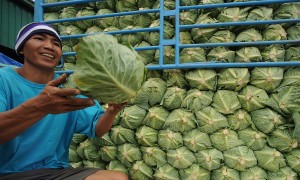Tourists flock to sites outside Baguio City

TOURISTS may buy cheaper vegetables at the La Trinidad Trading Post in the province of Benguet (photo by EV Espiritu, Inquirer Northern Luzon).
By Kimberlie Quitasol
Inquirer Northern Luzon
BAGUIO CITY—You won’t know what real cold is in the Philippines until you trek to Mt. Sto. Tomas or the upland towns in Benguet, like Atok, which hosts the highest point of the Philippine highway system.
Tourists endured traffic jams to reach Sitio Pungayan in Tuba town on Mt. Sto. Tomas, Benguet, during the Christmas holiday because it was the location of a popular television soap opera.
On Jan. 9, tourists who climbed Sto. Tomas experienced the temperature drop to 7.5 degrees Celsius, the coldest this month.
Cold has been the primary attraction of Baguio, the summer capital. But it is no longer the center of that universe after its frequent visitors discovered its neighboring towns.
Pungayan is the flavor of the year.
Long before the soap opera drew the attention of tourists to Sto. Tomas, they had been visiting the strawberry farms in the Benguet capital of La Trinidad, and the hot springs and woodcarvers’ shops in Asin village in nearby Tuba town.
Inspired by this newfound love affair with Benguet, the city’s neighboring towns suggested building new roads that would bring tourists straight to their communities, skipping the summer capital.
Many motorists enter Baguio to access tourist destinations in the Mountain Province and Ifugao province through the Halsema Highway, which begins in La Trinidad.
But at the height of the monstrous traffic jams last month, police and tourism officials tracked many motorists to Mt. Sto. Tomas, Tuba and La Trinidad.
Because of this new tourist behavior, Benguet officials now believe that building wider circumferential roads that connect their towns will ease Baguio’s traffic problems, said Mayor Ruben Paoad of Tublay, Benguet.
Tublay is part of an economic-sharing cooperative called BLISTT (the acronym for Baguio and the Benguet towns of La Trinidad, Itogon, Sablan, Tuba and Tublay), which has been discussing common solutions to the towns’ respective problems with tourism, traffic, water supply and waste management.
Paoad said the government should build or improve roads connecting Sablan to Tublay, Tublay to Itogon, and Itogon to Tuba that motorists can take, instead of entering Baguio or La Trinidad.
“Tourists driving their own vehicles would not contribute to the heavy traffic at the center [of Baguio] if they go through these alternative routes,” he said.
Tublay has a network of caves which can be visited by tourists, particularly those who do not have time to visit Sagada town in the Mountain Province, he said.
The proposed road network will also allow tourists to buy fresh vegetables at the source, yet another reason to take the trip to the north, other than going to the summer capital.